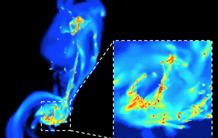
Thanks to very high resolution numerical simulations, CEA and CNRS astrophysicists led by Florent Renaud were able to analyse in detail for the first time the effects of turbulence generated during the collision of two galaxies. These numerical simulations, by resolving the disordered movements of the gas contained in galaxies down to very small scales, finally explain a phenomenon observed by astrophysicists but hitherto misunderstood: star formation "flare-ups" during galaxy collisions. A process of compressive turbulence helps explain these outbreaks, and why some galaxies form more stars than others. These results were published in Monthly Notices of the Royal Astronomical Society Letters on May 12, 2014.
Click here to read the press release in French on the CEA website

